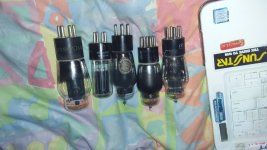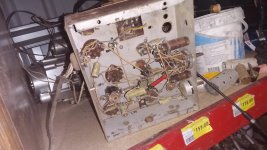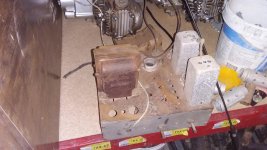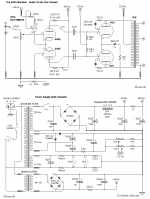TDXIII,
A SS diode rectified B+ version will use a different principal power transformer, but, in all other aspects, the list remains unchanged.
Perhaps you are thinking the magnetics list is just for the power supply. That's not the case. Hammond 1609A O/P transformers (1/channel) substitute for the Bogen T2106-1 shown in the audio circuit of the vacuum rectified schematic. Magnetics are the "big ticket" items in any tube amp build's expenditure list. The Australian retail prices for Hammond magnetics already include the cost of shipment from their location of manufacture and any import duties levied by the government. You saw what shipping can do with that $80 Antek number.
A SS diode rectified B+ version will use a different principal power transformer, but, in all other aspects, the list remains unchanged.
Perhaps you are thinking the magnetics list is just for the power supply. That's not the case. Hammond 1609A O/P transformers (1/channel) substitute for the Bogen T2106-1 shown in the audio circuit of the vacuum rectified schematic. Magnetics are the "big ticket" items in any tube amp build's expenditure list. The Australian retail prices for Hammond magnetics already include the cost of shipment from their location of manufacture and any import duties levied by the government. You saw what shipping can do with that $80 Antek number.

Last edited:
Ahh, yeah I should have noticed that list was for both the amp and PSU side. That's not terrible then, from what I have seen the other items aren't too bad on price anyway.
By any chance, can you source an Australian made AWV 5AS4G? That rectifier is electrically equivalent to the 5U4GB and likely would give you approx. 20 years of service.
Of course, a current production ElectroHarmonix (EH) 5U4GB, which enjoys a solid reputation, will be just fine.
Of course, a current production ElectroHarmonix (EH) 5U4GB, which enjoys a solid reputation, will be just fine.
Can't see any obvious ones locally, I suspect I've just got to be patient on that front and wait for some good tubes to come up. Radiotron tubes seem pretty common here. I have some tubes that I found out in the back wood shed, in a radio preserved entirely in old wasp nests. 4 Radiotrons and one Sylvania unsure of their condition or model, probably not much use.
Attachments
Just for grins, take a look at the #42 datasheet.
I'm guessing the cylindrical bottle tube is a "recent" #80 rectifier specimen. That guess is consistent with the #80 and the Octal based 5Y3 being electrically equivalent.
FWIW, the "Coke bottle" shaped envelope is known as ST.
I'm guessing the cylindrical bottle tube is a "recent" #80 rectifier specimen. That guess is consistent with the #80 and the Octal based 5Y3 being electrically equivalent.
FWIW, the "Coke bottle" shaped envelope is known as ST.
I'd say you are right about the bottle tube due to the large "80" on the back. The tube has a fairly decent rattle to it and I'm not sure if that's a problem. It'd be nice if it worked since I have a socket for it as well.
Speaking of the socket, I'll have to check the radio it came from for other potentially handy parts.
Speaking of the socket, I'll have to check the radio it came from for other potentially handy parts.
The type 42 tube at the very left is the 6-pin equivalent of the octal 6F6. As Eli noted the type 80 to its right is the 4-pin equivalent of the 5Y3. The internal structures of the next two tubes to the right are difficult to see, but assuming they're 6.3 V types I'd say the one with six pins is an IF amplifier like a 6D6, and the one with seven pins is a pentagrid converter (combined local oscillator and mixer) like a 6A7. Neither of these is likely to be worth using in audio circuits. The last one on the right appears to be a dual diode-triode, perhaps a type 85. These were used for the detector, AVC (automatic volume control) and 1st audio circuits.
Please note that all three tubes on the right are missing their grid caps. They may still be good, but they'll need to have their caps replaced if they're to be used reliably. This involves gluing them on with some sort of heat-resistant cement and resoldering the grid lead.
Please note that all three tubes on the right are missing their grid caps. They may still be good, but they'll need to have their caps replaced if they're to be used reliably. This involves gluing them on with some sort of heat-resistant cement and resoldering the grid lead.
Last edited:
Variants of 6GK5/6FQ5A tubes
I thought the OP and readers would be interested in discussing the variants of 6GK5 tubes used in the Musical Machine. If not I could take it to a new topic.
I have been collecting parts for my “Musical Machine” build for some time and have been buying a few 6GK5 tubes for this purpose. However, there are NOS 6GK5, 6GK5/6FQ5A
AF=78
GM=15000 Micromhos
As well as 6FQ5
AF=60
GM=12000
And 6FQ5A
AF=74
GM=14000
My question: Has any Musical Machine builders used anything but the “pure” 6GK5 tubes? Are the later tubes marked 6GK5/6FQ5 the same? It appears that most sellers now have these rather than straight 6GK5. And finally, any experience with using 6FQ5A in the musical machine? It appears 6FG5 specs are far enough off hat it probably does not meet the requirements. There are also 2GK5, 3GK5 and 4GK5 tubes which might be a better alternative than the 6FQ5 series.
I thought the OP and readers would be interested in discussing the variants of 6GK5 tubes used in the Musical Machine. If not I could take it to a new topic.
I have been collecting parts for my “Musical Machine” build for some time and have been buying a few 6GK5 tubes for this purpose. However, there are NOS 6GK5, 6GK5/6FQ5A
AF=78
GM=15000 Micromhos
As well as 6FQ5
AF=60
GM=12000
And 6FQ5A
AF=74
GM=14000
My question: Has any Musical Machine builders used anything but the “pure” 6GK5 tubes? Are the later tubes marked 6GK5/6FQ5 the same? It appears that most sellers now have these rather than straight 6GK5. And finally, any experience with using 6FQ5A in the musical machine? It appears 6FG5 specs are far enough off hat it probably does not meet the requirements. There are also 2GK5, 3GK5 and 4GK5 tubes which might be a better alternative than the 6FQ5 series.
Sorry for my typo in “ It appears 6FG5 specs are far enough off hat it probably does not meet the requirements.”
I meant the 6FQ5 (not A version) is far enough off that it probably does not meet the “Musical Machine” requirements.
I meant the 6FQ5 (not A version) is far enough off that it probably does not meet the “Musical Machine” requirements.
Would tubes need to be strictly in matching pairs for this amp or could you just have individual bias adjustment like Mr Zenith suggested? It appears to be pretty hard to find matching pairs overseas, let alone within Australia.
O/P tube pairs need to be well matched in the transconductance (gm) parameter, even when individual bias trim pots. are present. Individual bias set capability allows for some discrepancy in the cathode current parameter.
World wide, small business owners sell what you need. Private message (PM) gingertube (Ian) of "Baby Huey" fame, for info. on who sells in "Oz" and NZ. My (U.S.A.) go to guy is Jim McShane and he has shipped world wide many times.
World wide, small business owners sell what you need. Private message (PM) gingertube (Ian) of "Baby Huey" fame, for info. on who sells in "Oz" and NZ. My (U.S.A.) go to guy is Jim McShane and he has shipped world wide many times.
Would tubes need to be strictly in matching pairs for this amp or could you just have individual bias adjustment like Mr Zenith suggested?
Of particular concern is the matching of 6GK5 pairs for the input tubes, since they will last much longer than the output tubes. I bought a good stash and will be matching them carefully in pairs on a custom jig at their proper operating conditions
I hope is ok to post on this thread, as I also need help on the 6GK5 Musical Machine. I built it using the 2008 power supply. The issue is when I run both channels, I get a buzzing noise. If I pull the preamp tubes one channel, the other channel works fine. If I swap and pull the other preamp tubes, the other channel sounds fine.
Troubleshooting: When one using one channel, both bias test points are within spec. 1v across the 15 ohm resistor on the 6v6s, 195v drop across the 82k|91k pair on the 6GK5's. Im using 6FQ5A's on the preamp side, they are matched to within .5 volt at the bias test point. Individually, each channel can be biased very nicely.
When plugging in both sets of preamp tubes I noticed that the voltages are out of balance at the preamp bias test point. Each pair will have one high and one low. I will get one tube of each pair at about 215v and one at about 170v drop across the 82k|91k pair.
I have gone over the schematic multiple times and it's driving me crazy. Any ideas what I am missing?
Troubleshooting: When one using one channel, both bias test points are within spec. 1v across the 15 ohm resistor on the 6v6s, 195v drop across the 82k|91k pair on the 6GK5's. Im using 6FQ5A's on the preamp side, they are matched to within .5 volt at the bias test point. Individually, each channel can be biased very nicely.
When plugging in both sets of preamp tubes I noticed that the voltages are out of balance at the preamp bias test point. Each pair will have one high and one low. I will get one tube of each pair at about 215v and one at about 170v drop across the 82k|91k pair.
I have gone over the schematic multiple times and it's driving me crazy. Any ideas what I am missing?
Puzzling situation. Could you describe the nature of the buzzing noise a bit? Is it mechanical or do you hear it on the speaker?
It might help if you could post the amp and power supply schematic that you built.
You wrote:” I will get one tube of each pair at about 215v and one at about 170v drop across the 82k|91k pair. ” Is this consistently the same tubes? What happens if you swap sides?
It might help if you could post the amp and power supply schematic that you built.
You wrote:” I will get one tube of each pair at about 215v and one at about 170v drop across the 82k|91k pair. ” Is this consistently the same tubes? What happens if you swap sides?
Puzzling situation. Could you describe the nature of the buzzing noise a bit? Is it mechanical or do you hear it on the speaker?
It might help if you could post the amp and power supply schematic that you built.
You wrote:” I will get one tube of each pair at about 215v and one at about 170v drop across the 82k|91k pair. ” Is this consistently the same tubes? What happens if you swap sides?
Buzzing noise is through the speakers. I have uploaded a sample clip here:
Post info | SndUp
Here is the schematic I used. Sorry the pics are cobbled together from the ones earlier in the thread.
I tried swapping the tubes, but I get the same voltages on the same sockets. Say sockets 1&2 are left channel 6GK5, 3&4 are right channel 6GK5. Voltages will measure as follows: 1&3=215v, 2&3=170v.
Attachments
Just to be clear, if you take out the 6GK5s in sockets 1&2 then you measure 195v across the anode resistors of both the 6GK5s in sockets 3&4? But when you put the tubes back in 1&2 you measure 215v at socket 3 and 170V at 4?
Have you measured the common HV supplied (specified as 306Vdc) to the 6GK5s with all tube in, and when 1&2 are removed?
In your previous post you wrote: “ Im using 6FQ5A's on the preamp side, they are matched to within .5 volt at the bias test point.” Where exactly do you measure this bias in the amp? Depending on where you measured 0.5 V that could be too much of a difference. Are you having a CCS for each pair of 6GK5s?
If
1. the CCS is common to both tubes in sockets 1&2 as well as 3&4, and
2. the common HV supply is 306 Vdc to all 6GK5s, and
3. you are certain the anode resistors are all at specified values, and
4. you have tested the 6FQ5s,
then I would be suspicious of the wiring of the sockets, or the contacts in the sockets, or the grounding scheme. Please check to see if you measure any voltage on the grids when there is no input.
Good luck!
Have you measured the common HV supplied (specified as 306Vdc) to the 6GK5s with all tube in, and when 1&2 are removed?
In your previous post you wrote: “ Im using 6FQ5A's on the preamp side, they are matched to within .5 volt at the bias test point.” Where exactly do you measure this bias in the amp? Depending on where you measured 0.5 V that could be too much of a difference. Are you having a CCS for each pair of 6GK5s?
If
1. the CCS is common to both tubes in sockets 1&2 as well as 3&4, and
2. the common HV supply is 306 Vdc to all 6GK5s, and
3. you are certain the anode resistors are all at specified values, and
4. you have tested the 6FQ5s,
then I would be suspicious of the wiring of the sockets, or the contacts in the sockets, or the grounding scheme. Please check to see if you measure any voltage on the grids when there is no input.
Good luck!
Does the -66V CCS supply stay stable when you connect both channels?
Your schematic looks a little off from what Poindexter designed. The draw of both channels’ may be overloading the supply to where both CCSs don’t meter properly.
Your schematic looks a little off from what Poindexter designed. The draw of both channels’ may be overloading the supply to where both CCSs don’t meter properly.
So it looks like I have some power supply issues. I took some measurements after work yesterday. In the end I did get both channels to work simultaneously, but not under ideal circumstances.
I can't seem to edit my post with the schematic, so I am attaching the correct ones to this post. Took me a while to find them. I am using an Antek AS-1T250 and an Amveco 62045. Since the Antek doesn't have a 12.6v winding, I copied the negative supply from the '07 schematic. Otherwise I followed the '08 schematic.
As-is, I obtained the following measurements:
6GK5 pairs installed || Negative supply || B+ 6GK5 || B+ 6V6
0 pairs || -72.4v || 313v || 313v
1 pair || -68.2v || 301v || 308v
2 pairs || -64.0v || 287v || 304v
I realized the 195v drop on the 6GK5 anodes was from a very old thread and 195v was the wrong number. I attempted to correct the voltage drop to get 102v on the anodes. Anyway in the process, I did hit a point where both channels played with no bad noise. However the measurements I got at that point seem way off:
Negative supply: -59.2
B+ to 6GK5: 276v
B+ to 6V6: 304v
Assuming 6GK5 left pair is 1&2, right pair is 3&4. Measurements taken across 41.3k resistors
1) 265v drop = 11v 3) 262v drop = 14v
2) 224v drop = 52v 4) 230v drop = 46v
So I'm not sure what to make of it. I don't know what it is supposed to sound like, but I thought it sounded very good. It definitely doesn't have the gain that it should. Should I just leave it as it is since it is making music?
This is my first tube amp build, and I had tabled it for a couple years because I figured I did something stupid not following the schematics. But my wife said I have to finish this before I can start another amp...
I can't seem to edit my post with the schematic, so I am attaching the correct ones to this post. Took me a while to find them. I am using an Antek AS-1T250 and an Amveco 62045. Since the Antek doesn't have a 12.6v winding, I copied the negative supply from the '07 schematic. Otherwise I followed the '08 schematic.
As-is, I obtained the following measurements:
6GK5 pairs installed || Negative supply || B+ 6GK5 || B+ 6V6
0 pairs || -72.4v || 313v || 313v
1 pair || -68.2v || 301v || 308v
2 pairs || -64.0v || 287v || 304v
I realized the 195v drop on the 6GK5 anodes was from a very old thread and 195v was the wrong number. I attempted to correct the voltage drop to get 102v on the anodes. Anyway in the process, I did hit a point where both channels played with no bad noise. However the measurements I got at that point seem way off:
Negative supply: -59.2
B+ to 6GK5: 276v
B+ to 6V6: 304v
Assuming 6GK5 left pair is 1&2, right pair is 3&4. Measurements taken across 41.3k resistors
1) 265v drop = 11v 3) 262v drop = 14v
2) 224v drop = 52v 4) 230v drop = 46v
So I'm not sure what to make of it. I don't know what it is supposed to sound like, but I thought it sounded very good. It definitely doesn't have the gain that it should. Should I just leave it as it is since it is making music?
This is my first tube amp build, and I had tabled it for a couple years because I figured I did something stupid not following the schematics. But my wife said I have to finish this before I can start another amp...
Attachments
- Home
- Amplifiers
- Tubes / Valves
- 6GK5 Musical Machine Help





